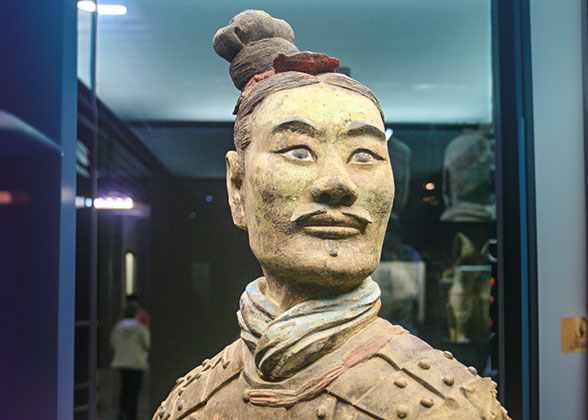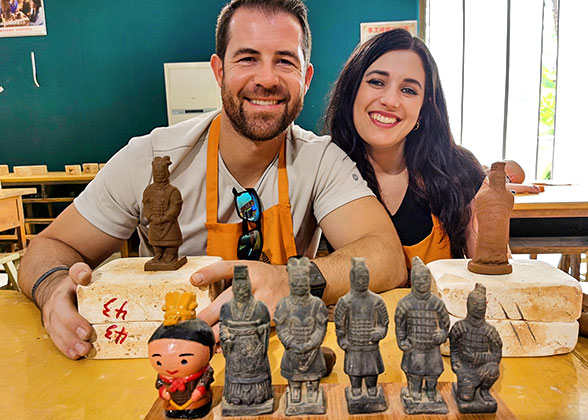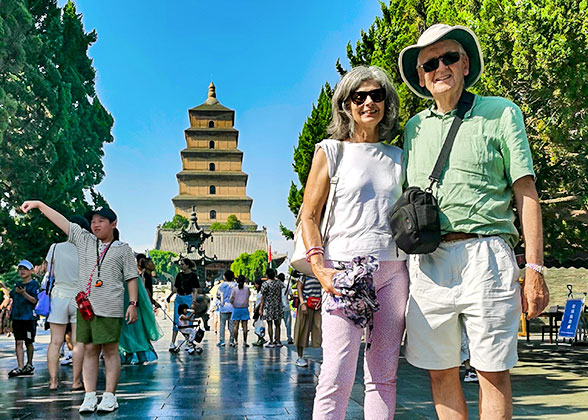1. The Terracotta Army has a history of over 2,200 years.
According to historical records, Emperor Qin Shi Huang, China's first emperor, started building his mausoleum when he ascended the throne in 247 BC. Most archaeologists believe the Terracotta Army was also built around that period, beginning around 247 or 246 BC. The project remained unfinished when the emperor died, and his son, Hu Hai, continued work until 208 BC, when it was stopped due to a large-scale peasant uprising. As a result, the Terracotta Army has a history of over 2,200 years.
See more about:
History of Terracotta Army
When was the Terracotta Army Built?
2. There are more than 8,000 terracotta warrior figures.
Based on current archaeological discoveries, it is estimated that there are about 8,000 terracotta warriors and horses buried in the Terracotta Army pits. In Pit 1, over a thousand figures have been uncovered, and based on their density, the pit likely contains around 6,000 warriors and horses. Pit 2 is thought to hold more than 1,300 figures, while Pit 3, which has been fully excavated, contains 68 figures.
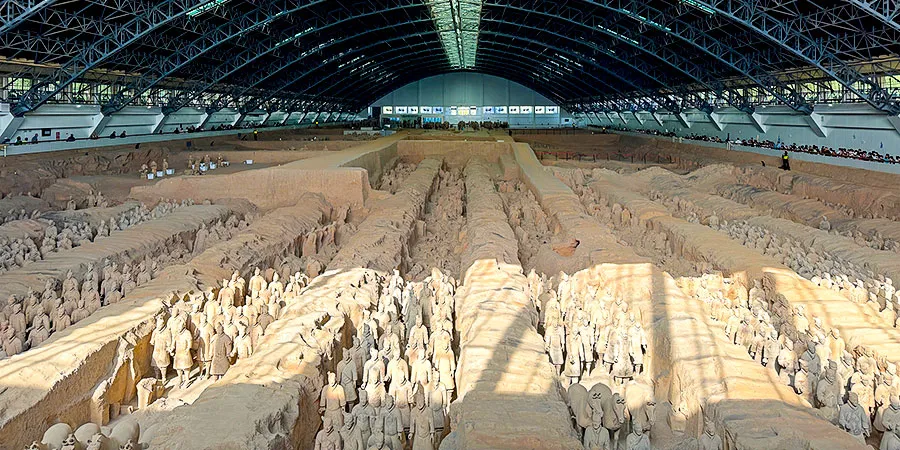 |
| Terracotta Army in Xi'an |
See more about:
Military Formation
How many Terracotta Warriors are there in China?
3. The Terracotta Army is praised as the Eighth Wonder of the World.
When the Terracotta Army was discovered in Xi'an in 1974, its enormous scale, impressive craftsmanship, and profound historical value amazed the world. It is often called the "Eighth Wonder of the World," a title first given by former French Prime Minister Jacques René Chirac during his visit in 1978. Additionally, it was officially listed as a UNESCO World Heritage Site in 1987.
4. The faces of each terracotta warrior are all different.
When visiting the Terracotta Army, visitors may notice that no two faces look exactly the same. This is because the terracotta warriors were modeled after real soldiers from the Qin Dynasty (210 - 207 BC), and the craftsmen paid great attention to detail. Even down to the eyes, eyebrows, beards, and wrinkles, they were all depicted very realistically, giving each figure a unique expression and age characteristic. This also makes the army not only orderly but also full of individuality.
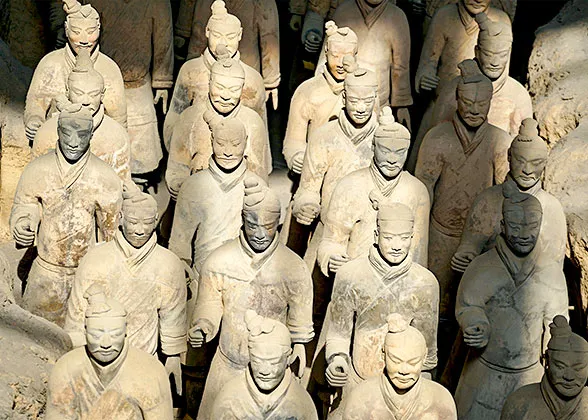 | | Warriors with Different Facial Features | | 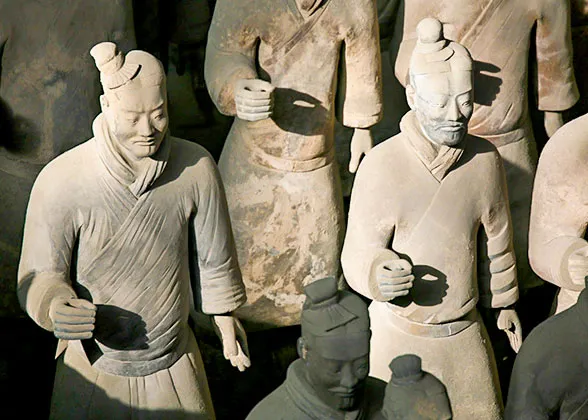 | | Life-like Infantry Warriors | |
Read more:
Face Shapes of Terracotta Warrior 5. The terracotta warriors were not originally grey.
Although the warriors appear greyish-brown today, they were originally brightly painted. Research shows that they were painted with more than ten different colors. So why did the color disappear? After being buried for over 2,000 years, the painted layers on the surfaces of the terracotta warriors became very fragile. Once exposed to outside air, changes in factors such as humidity caused the painted layers to curl and fall off quickly, leaving the grey color we see now.
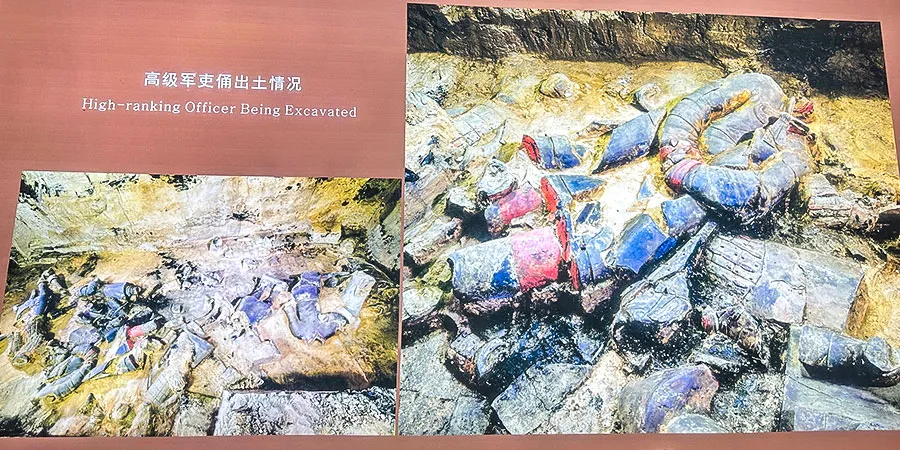 |
| Originally Colored High-ranking Officer |
See more about True Colors of Terracotta Warriors
6. The Terracotta Army is located in Xi'an, China.
The Terracotta Army is part of the Emperor Qinshihuang's Mausoleum Site Museum in Lintong District, Xi'an, Shaanxi Province. It's about 40 kilometers (25 miles) from downtown Xi'an, roughly an hour's drive away.
You may like: Where are the Terracotta Warriors Located?
7. Some timbers used for Terracotta Army pits came from high-altitude mountains.
Recent research has shown that some of the timbers used in the Terracotta Army pits were sourced from high-altitude mountain areas far from the mausoleum. This raises the question: why did the craftsmen choose timber from more distant, difficult-to-transport locations rather than local sources?
Archaeological sampling offers the answer: the earlier-built Pit K9801 mainly used timber from nearby low-altitude areas. In the slightly later Pit K9901, the proportion of low-altitude timber decreased, while the use of high-altitude timber increased. Finally, in Pit 1 and Pit 2 of the Terracotta Army, completed in the final stages of the project, an impressive 96% of the timber came from high-altitude regions. This trend clearly shows that as the massive mausoleum project advanced and its demand for timber grew, the supply of quality wood from nearby low-altitude areas was exhausted. This shortage forced the project to rely on timber from high-altitude mountains, despite the greater transportation challenges.
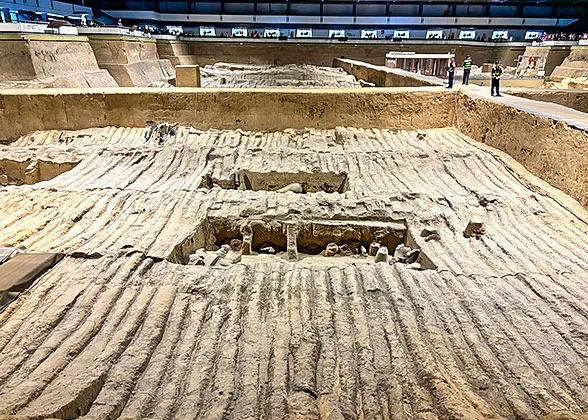 | | Timbers on the Roof of Pit 2 | | 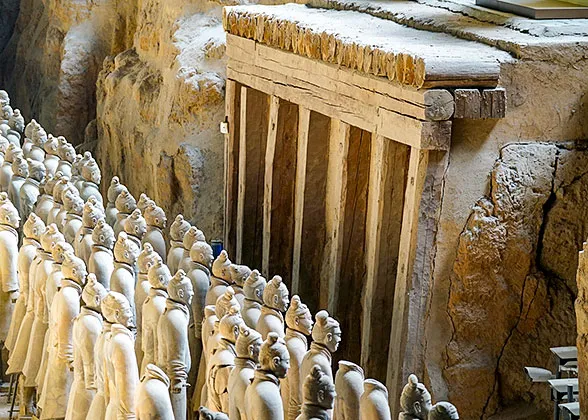 | | Timbers in Pit 1 | |
8. The production of terracotta warriors involves seven steps.
The production of the terracotta warriors was a complex process, primarily because their torsos, arms, hands, and heads were crafted separately. Craftsmen then carved intricate details like facial expressions, hairstyles, and armor onto these parts before assembling them into a complete figure. The assembled warrior was reinforced with fine clay. Next, it was fired in a kiln at temperatures around 1,000°C (1,800°F). After firing, the figure was painted with colored pigments, bringing it to life.
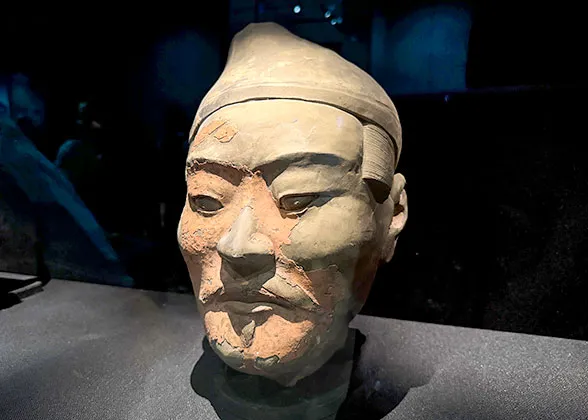 | | Colored Head of Warrior | | 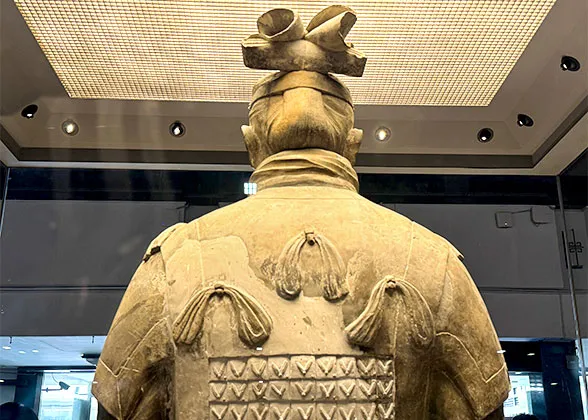 | | Details of Hair Style and Armor | |
See more details in
How the Terracotta Warriors Were Made? 9. The Terracotta Army was built for Qin Shi Huang's afterlife.
The Terracotta Army was built to serve Emperor Qin Shi Huang in the afterlife, supported by both archaeological findings and historical accounts. Inscriptions on bronze weapons excavated from the pits, for example, include the name of Lü Buwei, the emperor's chancellor, and the official workshops responsible for weapon production during his reign. Functionally, the army was designed to guard the emperor's tomb, expand his territory in the underworld, and maintain his imperial rule. At the same time, this impressive military formation also symbolized the Qin dynasty's strong military power and demonstrated the emperor's historic unification of China.
You may like:
Who Built the Terracotta Army?
Why was the Terracotta Army Built?
Who's the Real Owner of the Terracotta Army?
10. The Terracotta Army was discovered accidentally by local farmers.
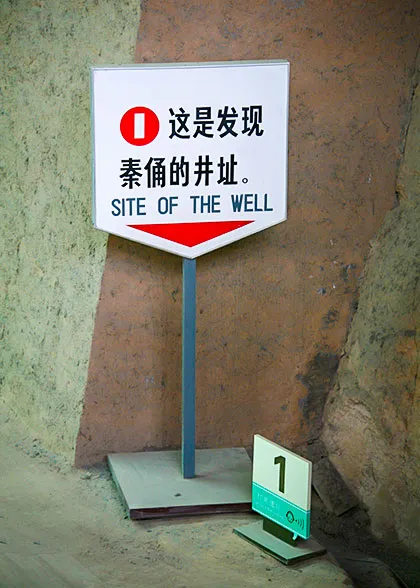 |
| Original Site of the Well |
It's remarkable that these significant imperial burial pits were discovered not by archaeologists but accidentally by local farmers. In March 1974, nine farmers, Yang Zhifa, Yang Peiyan, Yang Xinman, Yang Quanyi, Yang Wenxue, Yang Yanxin, Yang Yizhou, Yang Wenhai, and Wang Puzhi, were digging a well near Xi'an when they uncovered several broken, life-sized pottery figures. This accidental discovery led to an archaeological excavation that eventually revealed this grand underground army.
Read more:
Discovery of Terracotta Army in 1974
Who discovered the Terracotta Warriors?
11. The partition walls in the pits served multiple functions.
The partition walls in the Terracotta Army pits were not ordinary earthen structures; they served crucial purposes. Their primary function was as a load-bearing structure, bearing the weight of the thick layer of earth above and protecting the terracotta warrior figures from being crushed for centuries. Simultaneously, these walls organized the massive army into orderly units according to military branches. Additionally, they acted as physical isolation and protection walls, helping to contain potential fires or other disasters within one section and preventing them from spreading to adjacent areas.
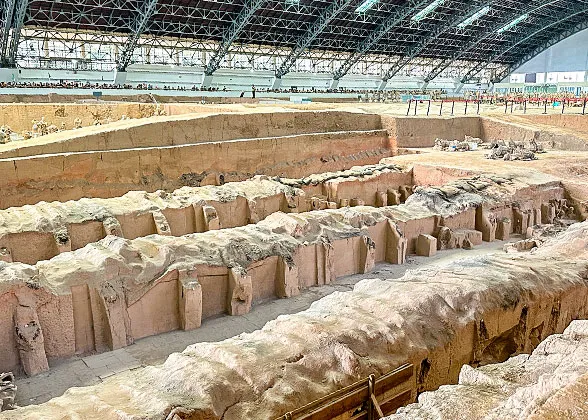 | | Partion Walls in Pit 1 | | 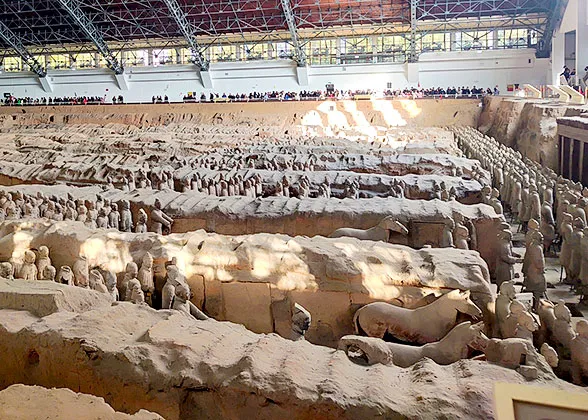 | | Warriors Isolated and Protected by Partion Walls | |
See more about
Why are there partition walls in the pits of Terracotta Army? 12. The terracotta warriors were not made of real humans, but of clay.
Research confirms that the unearthed terracotta warriors are hollow and contain no human bone fragments or tissues, proving they were not made from real people. Their primary material was yellow clay from the northern foothills of Mount Li, near the mausoleum. This clay had good plasticity for shaping. To prevent cracking during the drying and firing processes, a certain amount of grit containing quartz, mica, and feldspar was added to the clay mixture.
You may like: Were the Terracotta Warriors Made of Real Human Beings?
13. There are few historical records about Terracotta Army.
Why are there so few historical records of the massively scaled Terracotta Army? Experts suggest several reasons. Firstly, its construction was a highly confidential imperial project, and all involved were likely required to keep the information strictly confidential. Secondly, during the turmoil and frequent warfare at the end of the Qin dynasty, historians focused more on political and military events than on mausoleum construction. Furthermore, using terracotta figures as burial objects was not uncommon at that time, possibly making it less noteworthy for recording. Some people also believe that relevant records might have been lost or destroyed amidst the conflicts.
Read more in Why are there few historical records about Terracotta Warriors?
14. Tourists can see the terracotta warriors not only in Xi'an.
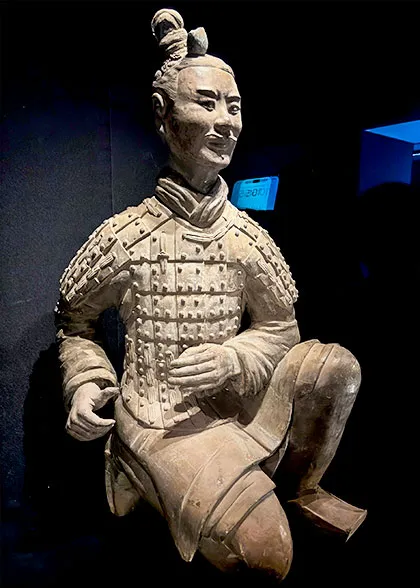 |
| Archer in Shaanxi History Museum |
While the Terracotta Army Museum in Xi'an remains the main site to see terracotta warrior figures, it is not the only place where they can be viewed. For example, the Shaanxi History Museum and other museums in different Chinese cities also display terracotta warriors. Moreover, since the 1980s, these figures have been featured in international exhibitions across countries such as the United States, the United Kingdom, Canada, and France. With more overseas exhibitions planned, it might eventually be possible to see the terracotta warriors in a museum near you.
You may like: 4 Sites of Terracotta Warriors besides Xi'an Terracotta Army
15. The excavation of the Terracotta Army is still ongoing.
The excavation of the Terracotta Army, a key part of the extensive mausoleum complex of Qin Shi Huang, is still ongoing. The entire mausoleum covers about 56 square kilometers (22 square miles), with only a small section of the discovered Terracotta Army pits uncovered so far. Currently, roughly one-third of Pit 1 has been excavated, along with one-fifth of Pit 2, while Pit 3 has been fully excavated. Future archaeological work is expected to continue for many years, potentially uncovering more terracotta figures of various types and styles.
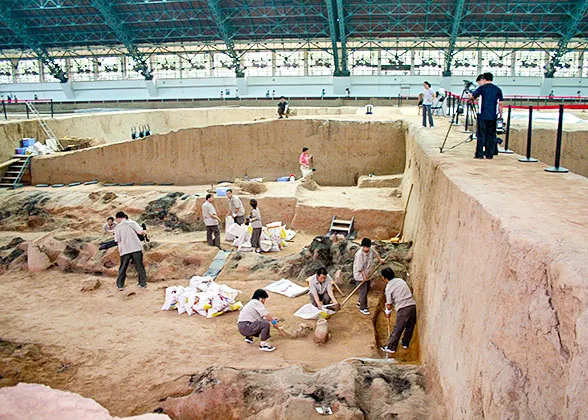 | | Excavation Work in Pit 1 | | 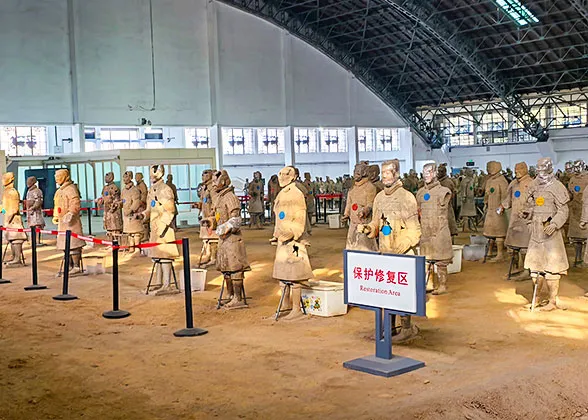 | | Preservation and Restoration Area in Pit 1 | |

Further Reading:
 Types of Terracotta Statues
Types of Terracotta Statues Terracotta Accessory Pits
Terracotta Accessory Pits Top 20 FAQs about Terracotta Army
Top 20 FAQs about Terracotta Army Overseas Exhibitions of Terracotta Army
Overseas Exhibitions of Terracotta Army Third Excavation of Pit 1 of Terracotta Army
Third Excavation of Pit 1 of Terracotta Army Second Excavation of Pit 2 of Terracotta Army
Second Excavation of Pit 2 of Terracotta Army What is the Terracotta Army? 10 Things You should Know
What is the Terracotta Army? 10 Things You should Know 8 Cool Facts You May Not Know about the Terracotta Army
8 Cool Facts You May Not Know about the Terracotta Army How to Visit Terracotta Army - A Perfect One-Day Tour Plan?
How to Visit Terracotta Army - A Perfect One-Day Tour Plan?
- Last updated on Nov. 17, 2025 by Doris Xue -














